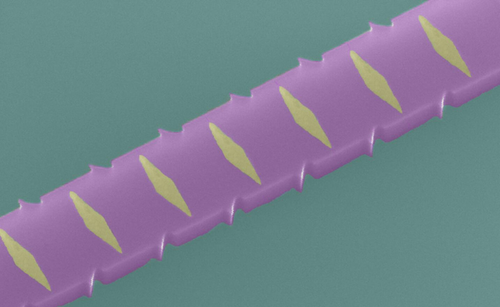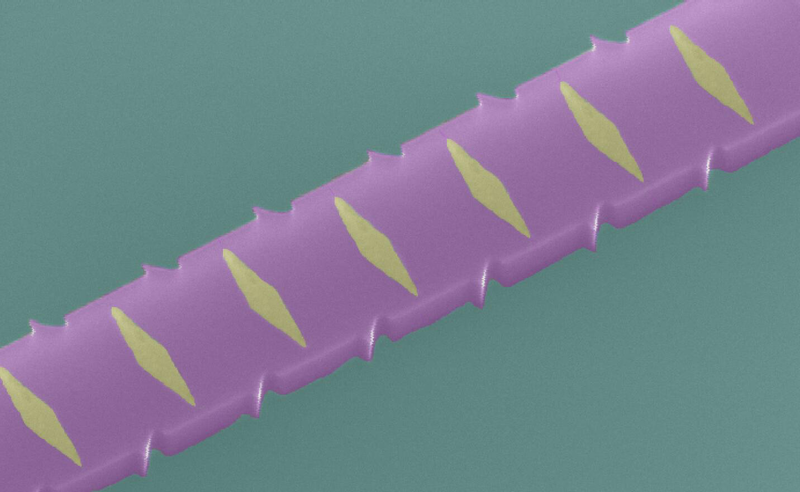Light Switched Off by Weaker Beam
Optical communication networks could be faster and more efficient if one light signal could affect another directly, rather than relying on intermediary electronic signals. Such all-optical switches typically require impractically high power, but a new switch design uses an asymmetric optical fiber to allow low-power switching. The power can be reduced by a factor of 3 compared to similar switches, but further tweaking of the materials could give power reductions of a thousand times or more.
An all-optical “on-off” switch receives an incoming light signal and either lets it through or blocks it depending on a control beam that arrives separately. For example, the switch might consist of a material that is normally transparent to the signal beam, but it turns opaque whenever the control beam exceeds some threshold power. The problem is that this threshold power is often too high to be practical.
Liang Feng from the State University of New York at Buffalo and his colleagues have designed a new optical switch that works with much lower power inputs. The basic component is an 800-nanometer-wide silicon optical fiber, or waveguide. With a segment of the fiber placed horizontally, the signal is an infrared laser beam that enters from the left end and is either transmitted out the right end or is absorbed within the waveguide, as determined by the control beam entering from the right. This switch uses destructive interference—the canceling of two waves that are maximally out of phase—which is an effect that works at low powers. The interference occurs between outgoing waves, which to the right of the waveguide consist of the transmitted part of the signal beam and the reflected part of the control beam. By tuning the phase of the control beam, the researchers can generate destructive interference on both sides of the waveguide, so that no light escapes—it all stays trapped in the fiber and eventually gets absorbed.
In previous experiments, other researchers have accomplished this canceling when the control and signal beams had equal power [1]. To produce the effect with a lower-power control beam, Feng’s team created asymmetric reflectivity. They added two types of nanosized elements in a repeating pattern along the length of the waveguide. The first element was an asymmetric notch that was carved into the side walls of the waveguide, causing a small variation in the index of refraction over the notch's length. Each notch reflects a portion of incoming light (like atoms in a crystal). The sum of the scattering from all of the sites produces a standing wave pattern inside the waveguide, with nodes (zero-field locations) and antinodes (maximal fields) that stay fixed in place.
The second element was a diamond-shaped pad—consisting of chromium and germanium films—that lay on top of the waveguide and absorbed light passing underneath. This absorption was stronger for light reflecting out to the left than for light reflecting to the right. The reason is that the positions of the scattering sites were not centered between the absorption sites, which introduced an asymmetry. The asymmetry was designed so that the antinodes in the standing wave for left-side reflection occurred roughly at the same place as the chromium-germanium pads, so a large fraction of light was absorbed. By contrast, the antinodes in the standing wave for right-side reflection largely missed the absorbers, so less light was lost.
In previous work, Feng’s team tuned the scattering and absorbing elements so that no light was reflected out the left side of the waveguide [2]. For the new switch, however, they engineered the waveguide so that the reflectance to the left was small but not zero. The asymmetric reflectance was chosen to allow the control beam to have one-third the power of the signal beam, and yet the amplitude of the reflected light would match the amplitude of the transmitted light on both the left and right sides of the waveguide. In demonstrations, the team showed that the destructive interference between these outgoing waves resulted in a millionfold decrease (60 decibels) in the transmitted signal. Feng says that further engineering could produce a switch that works with a control beam having 10,000 times less power than the signal.
Douglas Stone from Yale University is surprised by this result. He and others had developed switches that worked with equal powered inputs. “But we searched in vain for a setup where a weak beam strongly modulates a strong one. So I am impressed that they have found such a design and demonstrated it experimentally.” However, he says that the device in its “on” position is currently too lossy to be practical, so adding some gain material might be necessary.
This research is published in Physical Review Letters.
–Michael Schirber
Michael Schirber is a Corresponding Editor for Physics Magazine based in Lyon, France.
References
- W. Wan, Y. Chong, L. Ge, H. Noh, A. D. Stone, and H. Cao, “Time-Reversed Lasing and Interferometric Control of Absorption,” Science 331, 889 (2011).
- L. Feng, Y. L. Xu, W. S. Fegadolli, M. H. Lu, J. E. B. Oliveira, V. R. Almeida, Y. F. Chen, and A. Scherer, “Experimental Demonstration of a Unidirectional Reflectionless Parity-Time Metamaterial at Optical Frequencies,” Nature Mater. 12, 108 (2012).





